
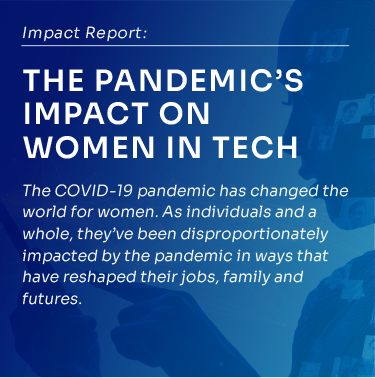
What’s Happened
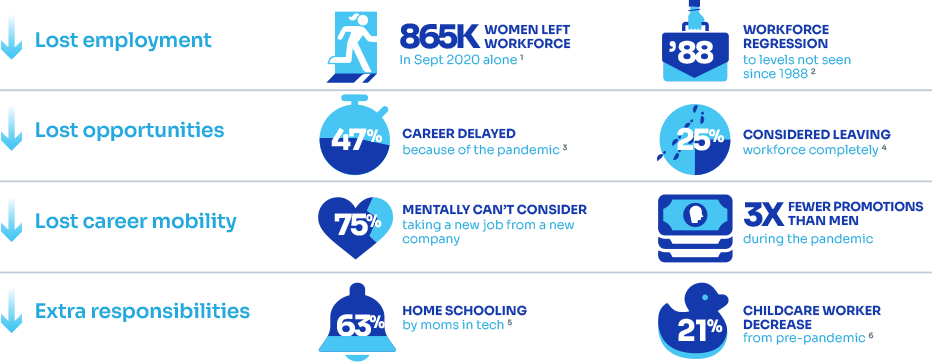
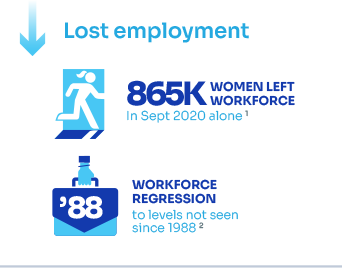
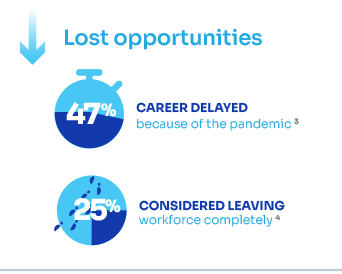
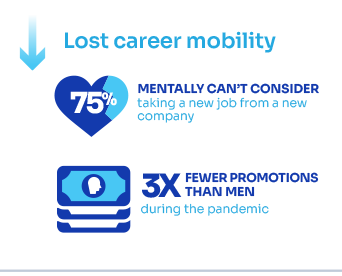
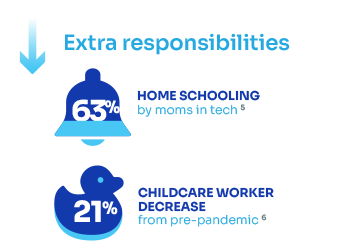
What We Can Do
COMPANIES
Promote from within – Create pathways and upward mobility for women already excelling within your organization. These women are looking for promotions and growth, but oftentimes must leave to get promoted. Change that by providing internal pathways for growth.
Become empathic leaders – Empathy has become the most critical leadership trait. Train leaders at every organizational level and value compassion.
Ensure a flexible environment – Women, and all employees, have figured out how to be productive, better balance life, work without commutes, support their families, and be great employees. The new work world must embrace these new conditions and build cultures that support flexibility.
Embrace remote workers – Studies now show that talent wants to live outside of the coast cities, and employees have proven they can be successful working from anywhere. Find ways to embrace your remote culture, promote talent that is remote, and expect a hybrid world for the future.
Be creative with schedules – A lot of women are looking for part time jobs—a completely underused talent pool. Create part time roles that women and other talent can be a part of to diversify your workforce.
WOMEN
Invest in yourself – Take advantage of every opportunity you are given and seek out others. Now is the perfect time to agree to work on other team projects, use your company’s training budget to help you improve your skills, and create a roadmap of skills and development that is important to you and start working on it.
Expand your network – Reach out and connect with mentors or leaders in new organizations and from past jobs. Engage in virtual networking and conversations to stay connected. Remember that relationships will help you navigate whatever is next.
Finding your next opportunity – If you have lost your job, reach out to your network and communicate what you are looking for. Take some classes (many are free) to improve the skills you know you need, and put yourself out there so others can help you.
BEFORE COVID
- In early 2000, women held more jobs than men in the U.S. workforce7
- A white house report revealed that essentially all of the income gains that middle-class American families have experienced since 1970 are due to the rise in women’s earnings.8
- Nearly two-thirds of all frontline workers are women.- 64%9
- “Women most often are the ones who adjust their schedules and make compromises when the needs of children and other family members collide with work.”10
IMPACT OF COVID
- Women lost 5.4 million jobs, or 55% of the 9.8 million jobs lost since February 2020.11
- Nearly 7 million Americans aren’t employed because they have to take care of children12
- The U.S. economy lost a net 140,000 jobs in December, but women lost 156,000 jobs in December – women accounted for 111% of jobs lost in December 2020.13
- In September, 865,000 women left the U.S. workforce – four times more than men.14
- The share of women in the workforce is down to levels not seen since 198815
- “Nearly half of women in tech feel their career had been delayed because of [Covid].”16
- 63% of mothers working in tech say they had done more home-schooling in the past year than their partners.17
MOVING FORWARD
- Only 9% of employees said they want to work in an office all the time
- 91% would like at least some time working from home18
- 39% of these said they’d like to work from home 3-4 days per week.19
- 59% say their work-life balance is better working from home20
- Staying put – findings from our own community about the difficulties of switching jobs right now
Infographic Statistics
Professional Advances for Women
- Record number of Female Fortune 500 CEOs – 3821
- but there are still nearly 13 companies run by a man for every company run by a woman.”22
- Women CEOs – across all industries – averages 6%23
- Retail is highest with 12%
- Healthcare is lowest with 1%
- Tech is 5%
- Women held C-suite jobs – averages 25%24
- “A larger number of women in leadership roles leads to higher profits,”25
- Tech is 23%
- Average 55% of the C-suite positions held by women are Chief of Human Resources
- Women hold 20.4% of board seats nationally.26
- “on average, companies with the highest percentage of female board directors outperform those with the smallest percentage by up to 66 percent.”27
- There are 650 open, women-designated board seats in California.28
- More Women are managers:
- Of the nearly 4.5 million new jobs in management created since 1980, women have obtained the majority of them.”
- The positions are in lower paying industries and have lower seniority.29
- One study also found that “if first-level women managers were hired and promoted like men, there would be 1 million more women in management over the next five years.30
- Of the nearly 4.5 million new jobs in management created since 1980, women have obtained the majority of them.”
- In early 2000, women held more jobs than men in the U.S. workforce31
- 41% of these women were mothers and were the “sole or primary breadwinners for their families.”32
- An additional 23% of these women were co-breadwinning mothers, who contributed “at least 25% of their household’s income through their wages.”33
- In Utah specifically, the number of mothers who are primary breadwinners was 24%, with an additional 26% working as co-breadwinners.34
- A white house report revealed that essentially all of the income gains that middle-class American families have experienced since 1970 are due to the rise in women’s earnings.35
- Women’s jobs are often lower-paying
- Nearly two-thirds of all frontline workers are women.- 64%36
- Highest percentages in childcare – 85.2%, healthcare 76.8%
- Lowest in trucking, warehouse & postal service – 22.7%
- Women hold the majority of jobs in clothing and department stores and gift and souvenir shops.37
- “Women are more likely to have earned a bachelor’s degree by age 31 than men,”38
- “Many college majors that lead to high-paying roles in tech and engineering are male dominated, while majors that lead to lower-paying roles in social sciences and liberal arts tend to be female dominated, placing men in higher-paying career pathways, on average.”39
- At every education level, women’s share of the low-wage workforce is larger than mens40
- Women dominated lower paid industries
- Health Care, education, non-profit, human resources, customer service,41 retail
- Women make up 95% of the childcare workforce.
- When an occupation becomes female-dominated, pay declines42
- Nearly two-thirds of all frontline workers are women.- 64%36
Women are responsible for Childcare
- Women are more responsible for childcare
- “Women most often are the ones who adjust their schedules and make compromises when the needs of children and other family members collide with work.”43
- Women are “eight times more likely than men to look after sick children or manage their children’s schedules.”44
- “roughly one-in-four (27%) say they quit their job at some point for family reasons (compared with only 10% of men).45
- “mothers were 40 percent more likely than fathers to report that they had personally felt the negative impact of child care issues on their careers.”46
- According to a recent gallup poll, working women were reported to be 50% more likely to “care for children on [a] daily basis” than men.47
- Even when the woman in a dual income home earns more than her male spouse, she is 26% more likely to “care for children on [a] daily basis.”48
- Women need child care to for support in fulfilling both work and family responsibilities:
- One survey showed that “81% of women questioned [said] child-care factors such as cost, availability, flexibility and trust made a relatively strong or critical difference in their decision to be in the workforce.”49
- Between 2015 and 2020, the industry was estimated to grow $54.6 billion.50
- Families in the United States spend over a quarter of their earned income on childcare.51
- In 2018, over 41 million workers between the ages of 18 and 64 were caring for children under t in he age of 18. Nearly 34 million were caring for a child under 14.52”
- 2018 survey found that 83% of parents with children under 5 said finding affordable, quality care in their area was a serious problem.53
- Mothers who were unable to find a child care program were significantly less likely to be employed than those who found a child care program, whereas there was no impact on fathers’ employment.54
- One in five child care jobs was lost55
- Child are workforce is at 79% of its previous strength (before COVID).56
- Child care providers have additional costs associated with cleaning, personal protective equipment, and equipment and facilities modifications to meet public health guidelines.”57
Covids Effects on Women
- Women lost the majority of jobs
- Women lost 5.4 million jobs, or 55% of the 9.8 million jobs lost since February 2020.58
- Nearly 7 million Americans aren’t employed because they have to take care of children59
- How many of these are women?
- The U.S. economy lost a net 140,000 jobs in December, but women lost 156,000 jobs in December – women accounted for 111% of jobs lost in December 2020.60
- In September, 865,000 women left the U.S. workforce – four times more athan men.61
- The share of women in the workforce is down to levels not seen since 198862
- Women who have kept their jobs are feeling the negative impact
- “Nearly half of women in tech feel their career had been delayed because of [Covid].”63
- 63% of mothers working in tech say they had done more home-schooling in the past year than their partners.64
Moving Forward
- Lesson 1: Working remotely
- One study found
- Only 9% of employees said they want to work in an office all the time
- 91% would like at least some time working from home65
- 39% of these said they’d like to work from home 304 days per week.66
- 59% say their work-life balance is better working from home67
- Stats from WTC Survey
- One study found
- Lesson 2: Staying put
- Stats from WTC Survey
- Lesson 3: Growth in Tech
- Amazon increased market Capitalization from 970 billion in January 2020 to more than 1638 billion in February 2021
- During 2020, Zoom users increased from 10 million to 300 million.
- Disney+ reached its 60 million user mark four years in advance of initial projections.
Endnotes
- Gogoi, Pallavi. “Stuck-At-Home Moms: The Pandemic’s Devastating Toll On Women.” NPR, 28 Oct. 2020, Link.
- Gogoi, Pallavi. “Stuck-At-Home Moms: The Pandemic’s Devastating Toll On Women.” NPR, 28 Oct. 2020, Link.
- Turner, Jack. “Women in Tech Held Back by COVID-19 – Study.” Tech.co, 26 Jan. 2021, Link
- Nguyen, Lananh. Bloomberg.com, Bloomberg, 22 Jan. 2021, Link.
- Turner, Jack. “Women in Tech Held Back by COVID-19 – Study.” Tech.co, 26 Jan. 2021, Link
- Ewing-Nelson, Claire. “One in Five Child Care Jobs Have Been Lost Since February, and Women Are Paying the Price.” National Women’s Law Center, Aug. 2020, https://nwlc-ciw49tixgw5lbab.stackpathdns.com/….
- https://fortune.com/2020/01/13/us-workforce-women/
- https://obamawhitehouse.archives.gov/sites/default/files/docs/2015_erp_chapter_4.pdf
- https://www.cepr.net/a-basic-demographic-profile-of-workers-in-frontline-industries/
- https://www.msn.com/en-us/news/us/women-acc…
- https://www.bloomberg.com/news/articles/2020-09-30/
- https://www.msn.com/en-us/news/us/women-acc…
- https://www.npr.org/2020/10/28/928253674…
- https://www.npr.org/2020/10/28/928253674/…
- https://tech.co/news/covid-19-held-back-women-tech
- https://tech.co/news/covid-19-held-back-women-tech
- https://www.leadershipiq.com/blogs/leadershipiq/…
- https://www.leadershipiq.com/blogs/leadershipiq/…
- https://www.leadershipiq.com/blogs/leadershipiq/…
- https://edition.cnn.com/2020/08/04/business/…
- https://www.catalyst.org/research/historical-li…
- https://www.kornferry.com/about-us/press/….
- https://www.kornferry.com/about-us/press/….
- https://onlinemba.wsu.edu/blog/3-ways-fem…
- https://www.mckinsey.com/featured-insights/…
- https://onlinemba.wsu.edu/blog/3-ways-fema…
- https://www.hrdive.com/news/women-filled-…
- https://www.inc.com/erik-sherman/more-…
- Jess Huang, Alexis Krivkovich, Irina Starikova, Lareina Yee, and Delia Zanoschi, Women in the Workplace 2019 (LeanIn, McKinsey & Company, October 2019): p. 14
- https://fortune.com/2020/01/13/us-workforce-women/
- https://www.americanprogress.org/issues/…
- https://www.americanprogress.org/issues/…
- https://www.americanprogress.org/issues/…
- https://obamawhitehouse.archives.gov/sites/…
- https://www.cepr.net/a-basic-demographic…
- https://www.npr.org/2020/11/05/9302859…
- https://www.bls.gov/opub/ted/2018/wome…
- https://www.glassdoor.com/research/pipelin…
- https://nwlc.org/wp-content/uploads/2017…
- https://www.insightssuccess.com/5-five-…
- https://academic.oup.com/sf/article-abs…
- https://www.forbes.com/sites/maggiege…
- https://www.pewresearch.org/social-tr…
- https://cdn.americanprogress.org/content….
- https://news.gallup.com/poll/283979/…
- https://news.gallup.com/poll/283979/wo…
- https://www.cnbc.com/2019/04/10/wor…
- https://www.ibisworld.com/united-state…
- https://www.statista.com/chart/6190/uk-f…
- https://www.vox.com/2020/7/16/213241…
- https://www.americanprogress.org/issu…
- https://www.americanprogress.org/issu…
- https://nwlc-ciw49tixgw5lbab.stackpath…
- https://nwlc-ciw49tixgw5lbab.stackpath…
- https://nwlc-ciw49tixgw5lbab.stackpath…
- https://www.msn.com/en-us/news/us…
- https://www.bloomberg.com/news/a…
- https://www.msn.com/en-us/news/…
- https://www.npr.org/2020/10/28/…
- https://www.npr.org/2020/10/28/…
- https://tech.co/news/covid-19-held…
- https://tech.co/news/covid-19-held…
- https://www.leadershipiq.com/blog…
- https://www.leadershipiq.com/blog…
- https://www.leadershipiq.com/blog…